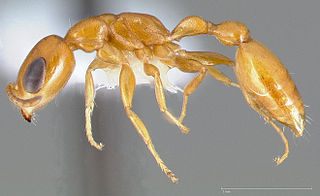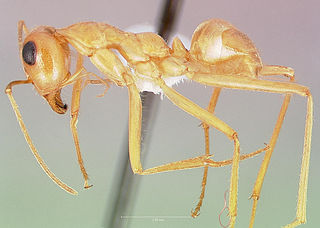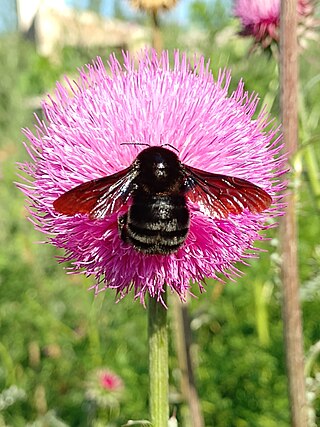
Formica exsecta is a species of ant found from Western Europe to Asia.

Myrmica rubra, also known as the common red ant or erroneously the European fire ant, is a species of ant of the genus Myrmica, found all over Europe and is now invasive in some parts of North America and Asia. It is mainly red in colour, with slightly darker pigmentation on the head. These ants live under stones and fallen trees, and in soil. They are aggressive, often attacking rather than running away, and are equipped with a stinger, though they lack the ability to spray formic acid like the genus Formica.

Formica rufa, also known as the red wood ant, southern wood ant, or horse ant, is a boreal member of the Formica rufa group of ants, and is the type species for that group, being described already by Linnaeus. It is native to Eurasia, with a recorded distribution stretching from the middle of Scandinavia to the northern Iberia and Anatolia, and from Great Britain to Lake Baikal, with unconfirmed reportings of it also to the Russian Far East. There are claims that it can be found in North America, but this is not confirmed in specialised literature, and no recent publication where North American wood ants are listed mentions it as present, while records from North America are all listed as dubious or unconfirmed in a record compilation. Workers head and thorax are colored red and the abdomen brownish-black, usually with a dorsal dark patches on the head and promensonotum, although some individuals may be more uniform reddish and even have some red on the part of the gastern facing the body. In order to separate them from closely related species, specimens needs to be inspected under magnification, where difference in hairyness are among the telling characteristics, with Formica rufa being more hairy than per example Formica polyctena but less hairy than Formica lugubris. Workers are polymorphic, measuring 4.5–9 mm in length. They have large mandibles, and like many other ant species, they are able to spray formic acid from their abdomens as a defence. Formic acid was first extracted in 1671 by the English naturalist John Ray by distilling a large number of crushed ants of this species. These ants primarily eat honeydew from aphids. Some groups form large networks of connected nests with multiple queen colonies, while others have single-queen colonies.

The pharaoh ant is a small (2 mm) yellow or light brown, almost transparent ant notorious for being a major indoor nuisance pest, especially in hospitals. A cryptogenic species, it has now been introduced to virtually every area of the world, including Europe, the Americas, Australasia and Southeast Asia. It is a major pest in the United States, Australia, and Europe.

The gyne is the primary reproductive female caste of social insects. Gynes are those destined to become queens, whereas female workers are typically barren and cannot become queens. Having a queen is what makes a "queenright" hive, nest, or colony of eusocial insects. A colony with multiple queens is said to be a polygyne form, whereas one with only one is a monogyne form.

Harpagoxenus sublaevis is a species of ant in the subfamily Myrmicinae. It is found in Austria, France, Germany, Italy, and Switzerland.

Rossomyrmex is a genus of slave-making ant in the subfamily Formicinae. The genus consists of four species, each with a single host from the genus Proformica, and has a very wide range of distribution from China to southeastern Spain, from huge extended plains to the top of high mountains.

Formica sanguinea, or blood-red ant, is a species of facultative slave-maker ant in the genus Formica characterized by the ability to secrete formic acid. It ranges from Central and Northern Europe through Russia to Japan, China, the Korean Peninsula, Africa and also the United States. This species is coloured red and black with workers up to 7 mm long.

Pseudomyrmex pallidus is a species of ant found in the Nearctic realm with an extensive range throughout the southern United States to Central America.

A gamergate is a mated worker ant that can reproduce sexually, i.e., lay fertilized eggs that will develop as females. In the vast majority of ant species, workers are sterile and gamergates are restricted to taxa where the workers have a functional sperm reservoir ('spermatheca'). In some species, gamergates reproduce in addition to winged queens, while in other species the queen caste has been completely replaced by gamergates. In gamergate species, all workers in a colony have similar reproductive potentials, but as a result of physical interactions, a dominance hierarchy is formed and only one or a few top-ranking workers can mate and produce eggs. Subsequently however, aggression is no longer needed as gamergates secrete chemical signals that inform the other workers of their reproductive status in the colony.

Worker policing is a behavior seen in colonies of social hymenopterans whereby worker females eat or remove eggs that have been laid by other workers rather than those laid by a queen. Worker policing ensures that the offspring of the queen will predominate in the group. In certain species of bees, ants and wasps, workers or the queen may also act aggressively towards fertile workers. Worker policing has been suggested as a form of coercion to promote the evolution of altruistic behavior in eusocial insect societies.

Formica truncorum is a species of wood ant from the genus Formica. It is distributed across a variety of locations worldwide, including central Europe and Japan. Workers can range from 3.5 to 9.0mm and are uniquely characterized by small hairs covering their entire bodies. Like all other ants, F. truncorum is eusocial and demonstrates many cooperative behaviors that are unique to its order. Colonies are either monogynous, with one queen, or polygynous, with many queens, and these two types of colonies differ in many characteristics.

Myrmecocystus mexicanus is a species of ant in the genus Myrmecocystus, which is one of the six genera that bear the common name "honey ant" or "honeypot ant", due to curious behavior where some of the workers will swell with liquid food until they become immobile and hang from the ceilings of nest chambers, acting as living food storage for the colony. Honey ants are found in North America, Australia, and Africa. Ant species belonging to the genus Myrmecocystus reside in North America. M. mexicanus in particular is found in the southwestern United States and parts of Mexico.

Temnothorax is a genus of ants in the subfamily Myrmicinae. It contains more than 380 species.

Liometopum apiculatum is a species of ant in the subfamily Dolichoderinae. Liometopum apiculatum ants are found in arid and semi-arid regions of southwestern United States and Mexico to Quintana Roo.

Slave-making ants or slaver ants are brood parasites that capture broods of other ant species to increase the worker force of their colony. After emerging in the slave-maker nest, slave workers work as if they were in their own colony, while parasite workers only concentrate on replenishing the labor force from neighboring host nests, a process called slave raiding.

An ergatoid is a permanently wingless reproductive adult ant or termite. The similar but somewhat ambiguous term ergatogyne refers to any intermediate form between workers and standard gynes. Ergatoid queens are distinct from other ergatogyne individuals in that they are morphologically consistent within a species and are always capable of mating, whereas inter caste individuals, another class of ergatogynes, often are not. Ergatoids can exhibit wide morphological differences between species, sometimes appearing almost identical to normal workers and other times being quite distinct from both workers and standard queens. In addition to morphological features, ergatoids among different species can exhibit a wide range of behaviors, with some ergatoids acting only as reproductives and others actively foraging. Ergatoid queens have developed among a large number of ant species, and their presence within colonies can often provide clues on the social structures of colonies and as to how new colonies are founded. Without wings, almost all species of ants that solely produce ergatoid queens establish new colonies by fission.

Temnothorax rugatulus is a species of ant in the genus Temnothorax. It is found in North America. More specifically, it is found in the forests of the western United States. Colonies are either monogynous or polygynous. Queens in monogynous colonies are generally larger (marcogynes), about twice the size of conspecific workers; polygynous colonies have smaller queens (microgynes), typically slightly smaller than the workers. T. rugatulus ants are a subdominant ant group.
This is a glossary of terms used in the descriptions of ants.

Bombus pauloensis is a neotropical bumblebee, formerly known as Bombus atratus, that is found throughout regions of South America, including Colombia, Ecuador, Brazil, and Argentina. It lives in social colonies that include a founder queen/queens, workers and brood. B. pauloensis is somewhat unusual because of its potential to oscillate between polygynous and monogynous nesting cycles. Bombus pauloensis was the first species in the genus Bombus that was discovered to display such polygynous nesting patterns. The polygynous nesting cycles lead to certain specific types of behavior including queen-queen aggression. Nests can also be perennial, which is a characteristic rarely found in other bumblebees. B. pauloensis can be helpful to agricultural because of their ability to pollinate different species of plants. B. pauloensis has been found to occupy a range of geographic areas and climates throughout South America. Colonies have the ability to thermoregulate nests and keep them a little bit warmer than the outside environment. Foraging workers use muscle contractions to maintain stable temperatures and coupe with seasonal and daily fluctuations in temperature.




















